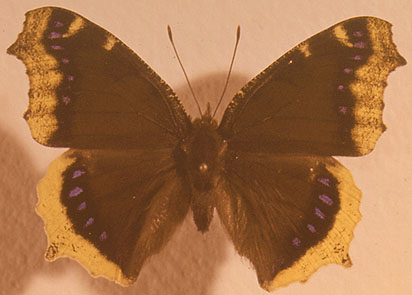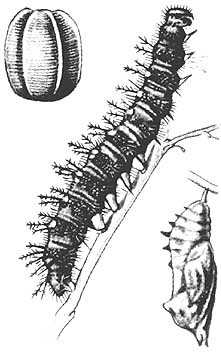
from a photo by J.R. Thomson.
BUG OF THE MONTH: March 1995
Mourning Cloak Butterfly
Order Lepidoptera, family Nymphalidae
Nymphalis antiopa
Copyright © 1995 by Louise Kulzer
This article originally appeared in Scarabogram, March 1995, New Series No. 179, p. 2.

|
|
Nymphalis antiopa adult; Vantage, Washington; from a photo by J.R. Thomson. |
One of the "winter" butterflies, the mourning cloak is often seen flying very early in the spring. Like other tortoiseshells and anglewings, the mourning cloak overwinters as an adult, even in areas with freezing winters. On sunny days, the mourning cloak's dark color and basking behavior allow it to raise its temperature well above the air temperature. The wings act as solar collectors, warming the hemolymph (blood) in the wing veins and returning the warmed fluid to the body until the butterfly reaches a temperature sufficient for flight (Christensen, 1981).
The larvae feed on the leaves of poplar, cottonwood, and willow, as well as elm and hackberry (Christensen, 1981). They are spiny, predominantly black but with white speckles and rows of red spots along the back. The spines are branched and look decidedly nasty. The larvae are gregarious and feed in groups. Sometimes they are so numerous they have earned a place in the annals of insect pests, where they are given the name "spiny elm caterpillar" (Collman, 1972).

|
|
N. antiopa egg, larva, and pupa |
Mourning cloaks are fairly easy to rear, although the larvae can be parasitized by wasps or flies. The adult lays eggs after mating in the spring, and the larvae feed through the spring & summer, pupating later in summer. The newly emerged adults fly in late summer and fall. The adults can be kept in captivity since they will feed on plant juices and fermenting fruit. Furthermore, adults can be overwintered in a cool, dark place, a little like geraniums. However, they need water and occasional food. I remember a small group of mourning cloaks kept by Anne Watkins in an unheated porch through the winter--in a covered bird cage! Anne would coax them to drink by applying water with a small paint brush. She said it kept them in good condition.
During rain breaks, be on the lookout for this cheerful harbinger of spring!
References:
Christensen, James R. 1981. A field guide to the butterflies of the Pacific Northwest. Northwest Naturalist Books, University Press of Idaho.
Collman, S. J. 1972. Insect pests of ornamental trees and shrubs of the University of Washington arboretum. M.S. Thesis, Univ. of Washington, Seattle.
This page last updated 16 June, 2005